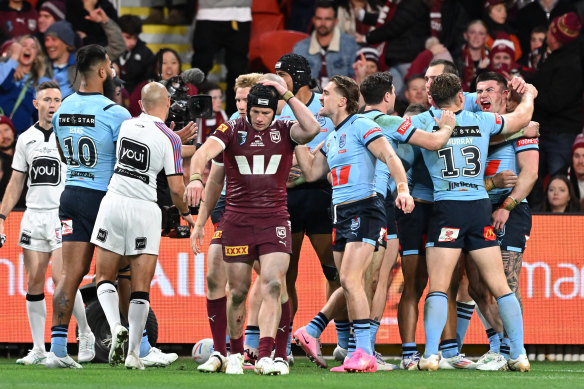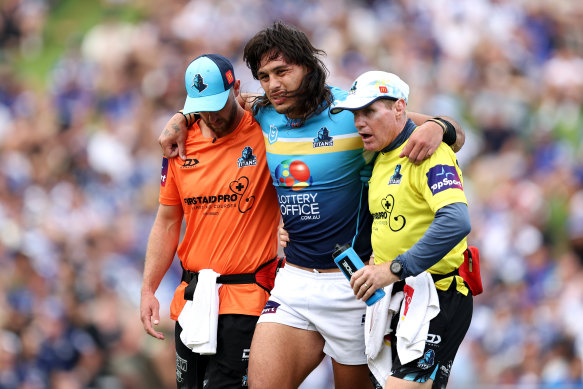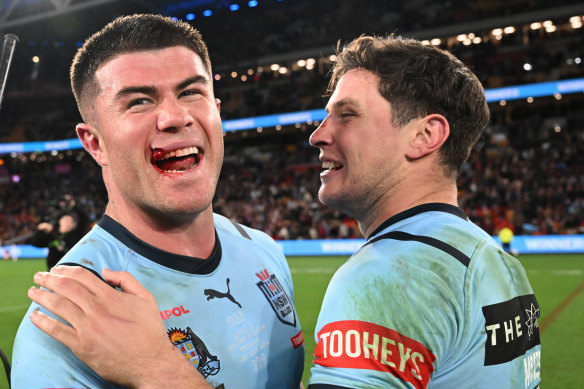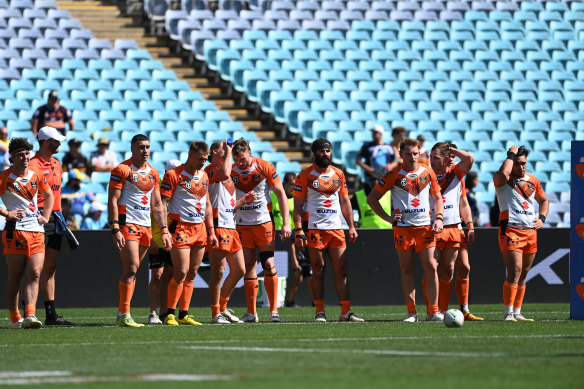Anyone able to open this article.
Queensland cannot rely on generational talents to keep popping up as they have in years gone by.

www.watoday.com.au
In the aftermath of Queensland’s State of Origin defeat, questions were immediately asked.
Was game three one of the all-time great games? Has there been a more committed defensive effort from two sides? Should Cameron Murray have been sent off for joining a fight from the bench?
But a query that should be considered relates to one of the biggest topics in the NRL world, and the game’s favourite buzzword: expansion.
The Queensland Maroons were largely battered throughout the 2024 State of Origin series by New South Wales.CREDIT: GETTY IMAGES
Rugby league wants to solidify itself as Australia’s leading sporting code. To achieve that, it needs a bigger footprint – and bold plans to take the game to Las Vegas and other new markets have inspired a plan for a 20-team competition.
A fifth Queensland team should be a stronger consideration, despite the narrative seemingly leaning towards bids in Perth, Papua New Guinea and New Zealand.
Loading
The Maroons’ series loss has also highlighted the issue of player depth, which another NRL club could help support, regardless of whether they ended up in an interstate outfit.
While Queensland coach Billy Slater professed he had the team to get the job done and they were simply outplayed, his outfit desperately missed three key men who could have made a difference.
Those were star forwards Tino Fa’asuamaleaui, Tom Gilbert and Thomas Flegler, all sidelined for the year through injury.
Queensland were also game one debutant J’maine Hopgood (back injury) and Jai Arrow (shoulder surgery), but neither are defined as enforcers in the same manner as the aforementioned trio.
Firebrand Raider Corey Horsburgh has also missed much of the season through injury and suspension, and the omissions Jaydn Su’a from the decider and David Fifita from the series drew confusion from rugby league pundits.
Could Tino Fa’asuamaleaui have helped turn around Queensland’s fortunes?CREDIT: GETTY
By contrast, the Blues looked the more intimidating pack even in their game-one loss.
Only the third Blues team to win a decider in Brisbane, they were aggressive, their big players stood up, and the work of their outside backs in supporting the forward pack cannot be understated.
Loading
The population and density of teams in NSW means that when the Blues suffer injuries, more options are at their disposal.
Among the three south-east Queensland clubs, only seven of the 94 contracted players played their junior football or grew up in the south Brisbane or western regions.
This is despite the fact the state hosts almost 40 per cent of the game’s total participants, yet NSW has 10 teams to feed.
Along with those teams comes elite coaching, junior academy pathways and the resources to have talent throughout the state jostling to compete with the best.
Bradman Best and Mitchell Moses both came into the Blues side for injured stars and turned in brilliant performances.CREDIT: GETTY IMAGES
When they lost Latrell Mitchell, they had Newcastle centre Bradman Best to call upon – who scored game three’s decisive try. Even still, they had Joseph Suaalii, Jesse Ramien, Kotoni Staggs and Tom Trbojevic waiting in the wings.
If anything had happened to the NSW engine room, the likes of Jacob Saifiti, Terrell May, Stefano Utoikamanu and Reagan Campbell-Gillard were waiting in the wings. All are among the competition’s top 50 for post-contact metres this season.
Because who does Queensland have coming through the ranks at present?
Max Plath has been a revelation for the Dolphins, but is more in the Reuben Cotter mould of a small, hard-working forward than a physically intimidating enforcer.
Corey Jensen has been strong this season, but is a “dig deep” variety of forward, rather than a player of impact and aggression.
The Gold Coast Titans and Brisbane Broncos have high hopes for Josiah Pahulu and Ben Te Kura respectively, but both are in the development stages.
The Maroons’ dominance in the past has often come from having some of the finest players of the modern era championing their cause in key positions.
The Brisbane Tigers are leading a bid to become Queensland’s fifth NRL team.CREDIT: NRL PHOTOS
Johnathan Thurston, Cameron Smith, Cooper Cronk, Darren Lockyer and Slater were all able to operate behind a workman-like pack and execute when a chance to attack struck.
For all the attacking class possessed by the likes of Daly Cherry-Evans, Tom Dearden, Harry Grant, Kalyn Ponga and Reece Walsh, ultimately their chances to strike were too few.
Queensland cannot rely on generational talents to keep popping up as they have in years gone by.
A fifth club in Queensland, with the
Brisbane Tigers leading a pitch to accommodate regions south of the Brisbane river and to the state’s west, would provide another crucial pathway to usher elite talent through to the Origin arena.


www.watoday.com.au




